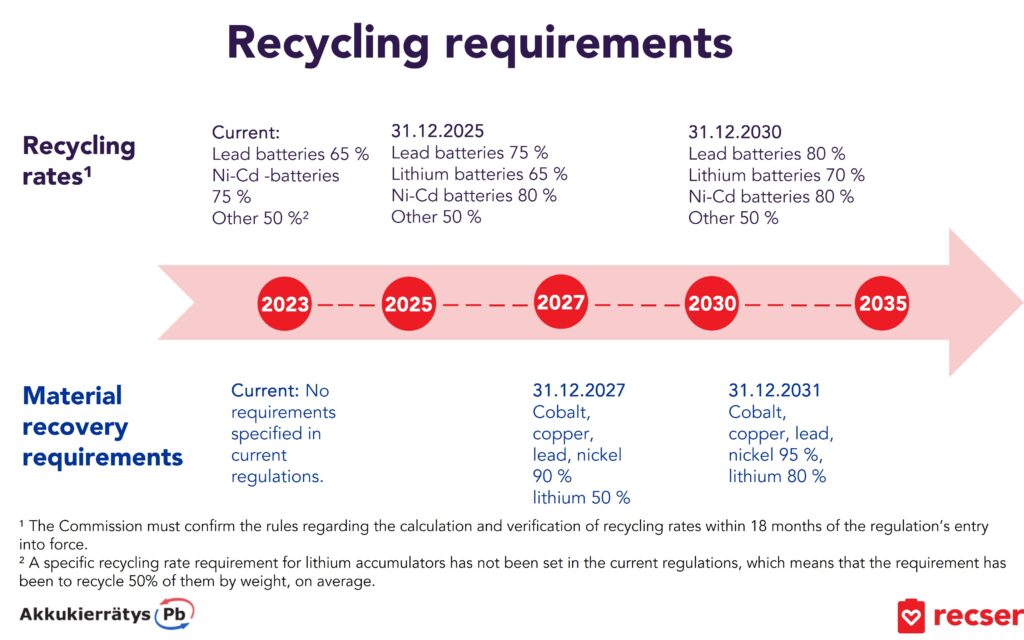The official Batteries Regulation draft negotiation text sheds light on the content of the upcoming regulation. There will be changes and specifications regarding producer responsibility. The regulation is expected to enter into force in late May–early June once the EU’s legislative bodies have officially verified it.
The Batteries Regulation will replace the directive of 2006, which is based on producer responsibility, i.e. the responsibility of the importers of batteries and accumulators to arrange the waste management and recycling of their products. Producer responsibility has been an efficient method of promoting the collection and recycling of discarded products.
The requirements concerning the entire life cycles of batteries and accumulators will now be uniform throughout the EU, and the links to product design, the role of the end user and the promotion of the recycled raw material market that were previously missing from the regulations will be introduced. These changes allow for producer responsibility to become a real accelerator and backbone of circular economy, around which the entire collection and recycling system will be built.
In the regulation, the producers’ responsibility is extended and more ambitious collection and recycling goals are set. In practice, producer responsibility is borne by producer organisations, such as Recser Oy and Akkukierrätys Pb in Finland. Producer organisations not only organise the collection and recycling of batteries and accumulators and prepare statistics but make it possible to reuse collected accumulators and arrange communications about collection and recycling as well.

New battery and accumulator categories
The accumulator categories of the new regulation will correspond better to the accumulators on the market. The existing categories of portable accumulators (which will only include batteries and accumulators weighing 5 kg or less), starter batteries and accumulators will also be in use in the future. New categories will be made for the product groups important for the green transition, i.e. the accumulators of electric cars and electric light means of transport (electric bicycles, mopeds and scooters). Different categories need to comply with different labelling and collection requirements, for instance.
The regulation will directly apply to the accumulators placed on the market of the Member State as well as the accumulators inside of equipment, machines, vehicles and means of transport placed on the Member State’s market.
Producer responsibility to apply to an increasingly large group
- The definition of a producer under producer responsibility has been specified to refer to the manufacturer, importer, distributor or distance seller of accumulators. The most significant change is that distance sellers now bear producer responsibility. Detailed definition of a producer (Article 2): is established in a Member State and manufactures batteries under its own name or trademark, or has batteries designed or manufactured and supplies them for the first time under its own name or trademark, including those incorporated in appliances, light means of transport or vehicles, within the territory of that Member State
- is established in a Member State and resells within the territory of that Member State, under its own name or trademark, batteries, including those incorporated in appliances, light means of transport or vehicles, manufactured by others. A reseller is not regarded as the producer if the brand of the manufacturer appears on the batteries, as provided for in point (i)
- is established in a Member State and supplies for the first time in this Member State on a professional basis, batteries, including those incorporated in appliances, light means of transport or vehicles, from a third country or from another Member State
- sells batteries, including those incorporated in appliances, light means of transport or vehicles, by means of distance communication directly to end-users, that are either private households or other than private households, in a Member State, and is established in another Member State or in a third country
The new regulation takes the increasing reusability and remanufacturability of the accumulators and the party under producer responsibility better into account. According to the regulation, an economic operator making available on the market for the first time within the territory of a Member State a battery that results from preparing for reuse, preparing for repurpose, repurposing or remanufacturing operations shall be considered as the producer of such battery (Article 47).
The main principle is that only accumulators the related producer responsibility of which has been taken care of can be placed on the market in Member States. Producers shall not make available batteries on the market of a Member State, if they or, in case of authorisation, their authorised representatives for the EPR, are not registered in such Member State. (Article 46)
No major changes in producer responsibility
There will be no major changes to carrying out producer responsibility, but the registration requirements to be made uniform throughout the EU will make the operations of multinational companies easier.
According to the regulation, producers under producer responsibility must register in (Article 46) or become a member of an approved producer responsibility organisation. Distance sellers must appoint an authorised representative for the EPR in each Member State it sells batteries. (Article 47) Member States may adopt measures to make the entrustment of a producer responsibility organisation mandatory (Article 47a) There are detailed requirements for registration and, in addition, producers and producer responsibility organisations are required to provide assurance.
Costs of municipal waste studies to be borne by producers
As is currently the case, producers are responsible for the costs of waste management, the provision of information and guidance and official reporting related to the batteries and accumulators that they place on the market.
According to the specifications in Article 47, waste management will continue to include the separate collection, transportation and processing of discarded batteries and accumulators. Specifications concerning the costs of processing mean that, in distributing the costs, the potential profits from the preparation for reuse and recycled materials must be taken into account.
The costs of carrying out a periodical compositional survey of collected mixed municipal waste are now borne by producers (Article 47(4)).
Responsibility and sustainability taken into consideration in the recycling fees of producer responsibility organisations
In the future, producer responsibility organisations must modulate the financial contributions paid to them by producers taking into account, in addition to the current requirements, the rechargeability, the level of recycled content in the manufacture of batteries and the fact that the batteries were subject to preparing for reuse, preparing for repurpose, repurposing or remanufacturing, and their carbon footprint (Article 47a(2)).
Producer responsibility organisation are given the chance to select the waste management service provider through a special selection process. Waste management service providers shall be subject to a non-discriminatory selection procedure, based on transparent award criteria, by producer responsibility organisations, without placing disproportionate burden on small and medium sized enterprises. Producer responsibility organisations shall make publicly available information on the selection procedure (Article 47a(6).
The collection targets that currently apply to Member States shall apply to producer responsibility organisations in the future. Producer responsibility organisations must also fulfil the collection targets or they may have their authorisation revoked by the competent authority (Article 47b(6).
Producers also responsible for collection
The producers of portable batteries and accumulators are responsible for the maintenance of a nationwide, easily accessible collection network (Article 48). Distributors retain their reception obligation and, in the future, collection points organised by municipalities must accept batteries and accumulators from consumers. Many municipalities in Finland have already organised a separate collection, but not all. In the future, the collection network organised by producers must include:
- Distributors that must accept discarded batteries and accumulators without charge and without the requirement to purchase a new product in their store or in its immediate vicinity in accordance with article 50. With regard to portable batteries and accumulators, the distributors’ reception obligation is limited to the amount of products typically discarded by non-professional end users. The regulation introduces a new obligation for distributors to offer to accept discarded batteries and accumulators without charge upon delivery or in a local pick-up point.
- End-of-life vehicle treatment facilities
- Public authorities (which probably refers to municipalities in Finland and their waste management plants), which, according to Article 53, must accept the batteries and accumulators offered by private end users.
- Voluntary collection points
- Waste electrical and electronic equipment treatment and recycling facilities that must hand over the batteries and accumulators resulting from the treatment of waste electrical and electronic equipment to the producers or to waste management operators selected by the producer (Article 52).
Producers may continue to be given the national priority to arrange collection as, as specified in Article 48(6), Member States may adopt measures to require that the collection points specified above must agree on the organisation of collection with producers. Alternatively or in addition to this, Member States may restrict the possibility of collection points to hand over collected batteries and accumulators (Article 54a).
According to the regulation, producers must provide collection points with the required collection and transport equipment in addition to the pick-up service. In the current division of responsibilities, producers are responsible for the process beginning from the back doors of distributors. Collection must be free of charge to end users and it is prohibited to set an obligation for the end user to purchase a new battery or accumulator or a requirement that the battery or accumulator to be returned was originally purchased from the producer organising the collection.
The collection targets of portable batteries and accumulators go up from the current 45% to 63% (by the end of 2027) and 73% (by the end of 2030). In order to better capture the actual volume available for collection, the Commission shall be empowered to adopt delegated acts to amend the methodology to calculate the collection rate of portable batteries and amend the target to adapt the rate to the new methodology while maintaining equivalent ambition and timelines prior to the introduction of new requirements (Article 48(8).
Member States responsible for organising municipal waste composition studies, carried out at the expense of producers in the future, at least every five years. Based on the results of the studies, competent authorities can order the producers to extend their collection network or arrange informative campaigns aimed at the end users.
Collection of light means of transport accumulators expanded
The regulation will introduce a major change regarding the accumulators of light means of transport (LMT) and the coverage of their collection network as the current regulations do not impose any reception obligations to the distributors regarding these.
In the future, the coverage of the LMT accumulator collection network and other requirements concerning collection are largely in line with the collection of portable batteries and accumulators specified above. As a special requirement, Article 48a(4) specifies that producers must provide the collection points with suitable collection infrastructure for the separate collection of waste volumes handed over that meet the applicable safety requirements. In addition, producers are responsible for covering the necessary costs incurred by collection.
LMT accumulators are also given their own, incrementally more demanding collection targets in the regulation: 51% (by the end of 2028) and 61% (by the end of 2031).
Starter battery and industrial accumulator collection cooperation to be expanded
There will be some changes to the collection of starter batteries and industrial accumulators, especially with regard to the collection network. Previously, producers and producer responsibility organisations were exclusively responsible for establishing the collection network, but now, it will be carried out in more extensive cooperation. Producers and producer responsibility organisations will continue to be responsible for the collection of accumulators, but the collection is organised in cooperation with the following parties (Article 49):
- Distributors of starter batteries and industrial accumulators. The reception of accumulators must take place without charge in a store or its immediate vicinity with regard to the accumulator categories sold by the distributor.
- Operators carrying out re-use, remanufacturing or repurposing of accumulators.
- Waste electrical and electronic equipment and end-of-life vehicle treatment facilities for the waste accumulators arising from their operations.
- Public authorities (which probably refers to municipalities in Finland and their waste management plants), which, according to Article 53, must accept the accumulators offered by private end users.
Member States may require operators specified in sections 1–3 to enter into a contract with the producer or producer responsibility organisation (Article 49). Producers are responsible for the organisation of collection infrastructure at collection points, covering the costs incurred by collection operations and, in particular, ensuring safety in the recycling of accumulators (Article 49).
As is the case with the current requirements, the accumulator collection network must cover the whole territory of the Member State (Article 49). Accumulators may be handed over by collection points to producers or producer responsibility organisations or delivered by waste management operators to recycling. Waste management operators responsible for collection are selected with regard to these accumulators based on the criteria set by producers/producer responsibility organisations in a selection procedure (p. 51 (76) and Article 47a).
Separate collection targets for raw materials
As is currently the case, producers must ensure that all batteries and accumulators collected separately or removed from appliances are processed and recycled with the best purposeful technique in accordance with the regulation’s requirements. Recycling plants must meet at least the following recycling rate targets, which are made incrementally more demanding (Article 57 and Parts B and C of Annex XII):

The regulation introduces new material-specific recycling targets for major raw materials. Recycling of accumulators must be arranged so that the majority of cobalt, nickel and copper, for example, is recovered by 2031. The recycling targets are made incrementally more demanding, and, by 2027, the following targets are in place:
- Lithium 50%
- Cobalt 90%
- Copper 90%
- Lead 90%
- Nickel 90%
End users are responsible for delivering discarded products for recycling
End users play an important role in recycling portable accumulators and batteries, in particular. The regulation sets an obligation for end users to collect discarded accumulators and batteries from other waste streams and to deliver them to the collection system maintained by producers (Article 51). Transparency is supported by the fact that costs covered by the producer must be shown separately to the end-user at the point of sale of a new battery (Article 60(5)).
As is currently the case, producers and producer responsibility organisations must inform end users about, for example, the battery and accumulator collection systems, labels concerning recycling and the importance of recycling. Furthermore, distributors must continue to inform end users about the possibility of returning accumulators for recycling (Articles 51 and 60).
In addition, producers must offer end users information and recommendations about the safe handling of discarded batteries and accumulators (especially batteries and accumulators that contain lithium), how to prolong their service life, their re-use and potential for repurposing. As a new requirement, producers are required to offer collection points and other waste management operators carrying out preparing for re-use, preparing for repurpose, and treatment, information regarding the safety and protective measures applicable to the storage and collection of waste batteries and accumulators (Article 60).
Longer transition period for waste management and producer responsibility provisions
During the preparation of the regulation, there was discussion about the suitability of a deposit system for batteries and accumulators. The topic was not directly included in the regulation, but the Commission was tasked with estimating whether such a system was feasible and useful, particularly with regard to portable batteries and accumulators, by the end of 2027 (Article 50a).
The provisions regarding waste management and producer responsibility specified in Chapter VII must be complied with after a transition period of 24 months after the regulation’s entry into force.
This article is based on a negotiation text
This article is based on a negotiation text prepared in the regulation’s preparation process written in English, and Recser Oy or Akkukierrätys Pb are not responsible for any deviations between the article and the final official text of the regulation or its interpretation or Finnish translation. The official Finnish translation of the regulation will probably be available this spring.
Also read our previous articles
- What does the EU’s new battery regulation mean?
- #BatteryRegulation: The EU aims to tighten the collection rate of batteries and accumulators and make the calculation methods more realistic


This article is a part of the joint communications of the battery and accumulator producer organisations Recser Oy and Akkukierrätys Pb Oy concerning the EU Batteries Regulation. You can also subscribe to our newsletter (Mailchimp) to receive the latest news on the subject.
